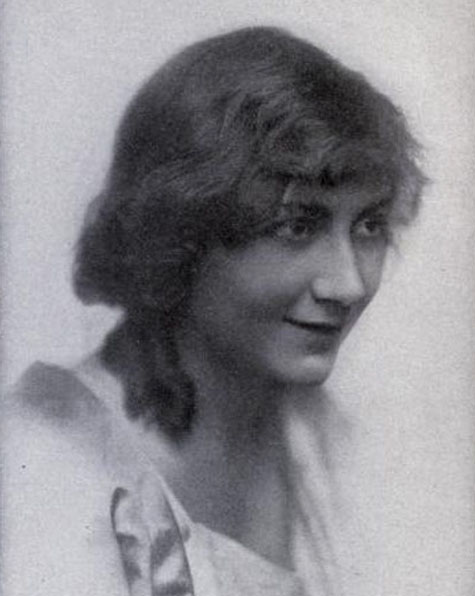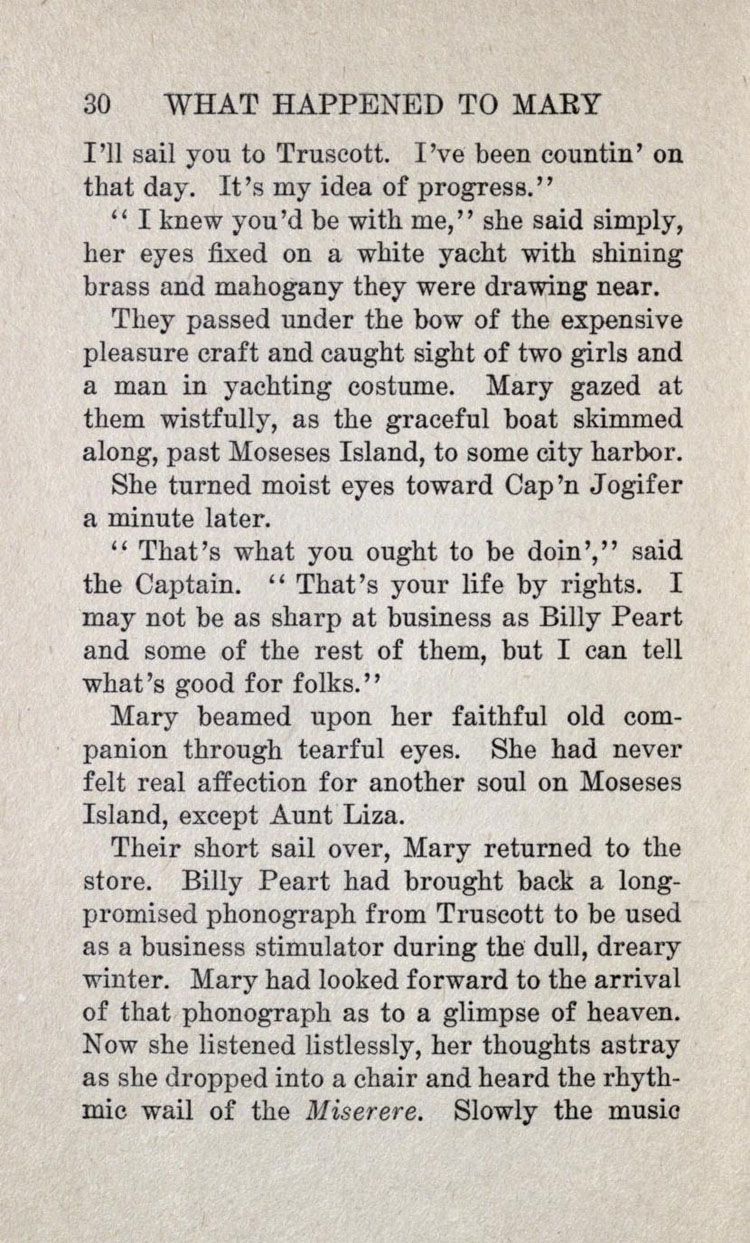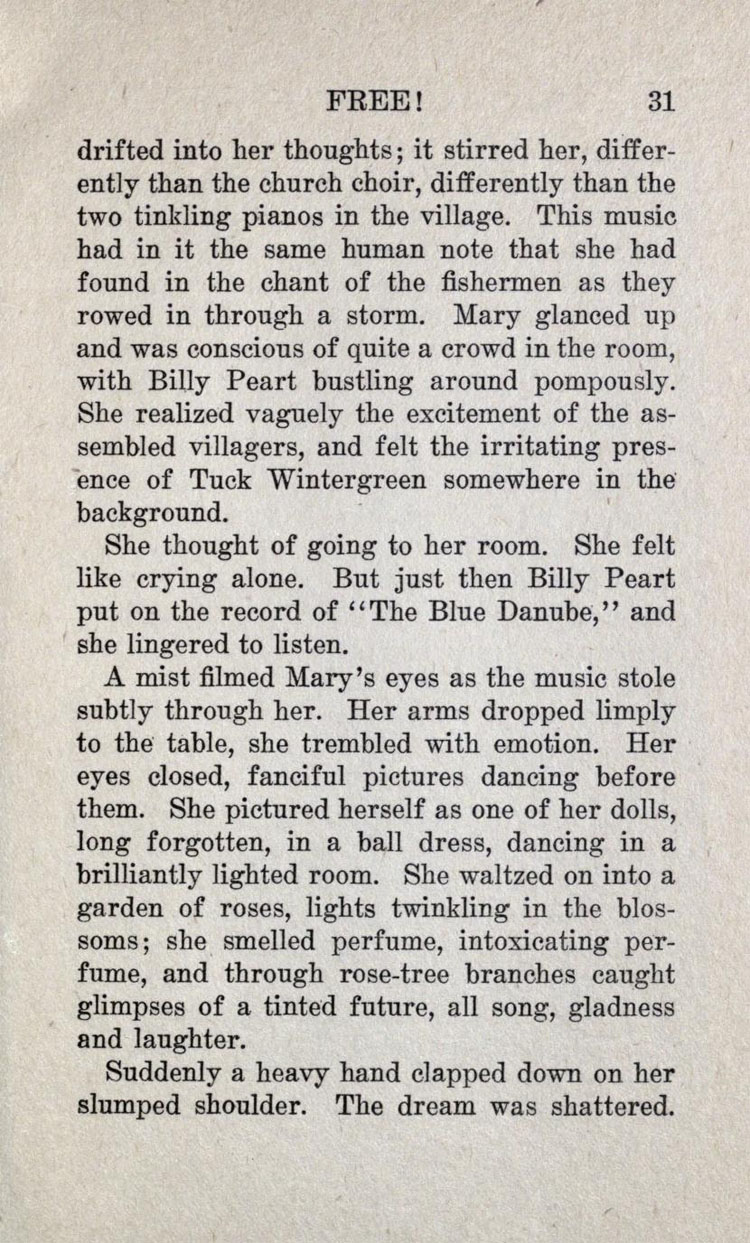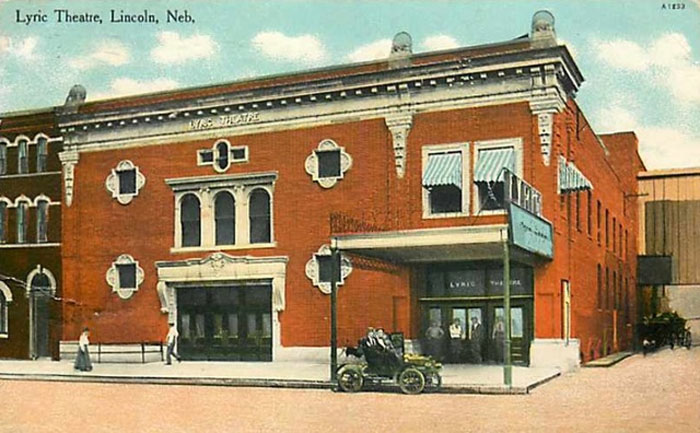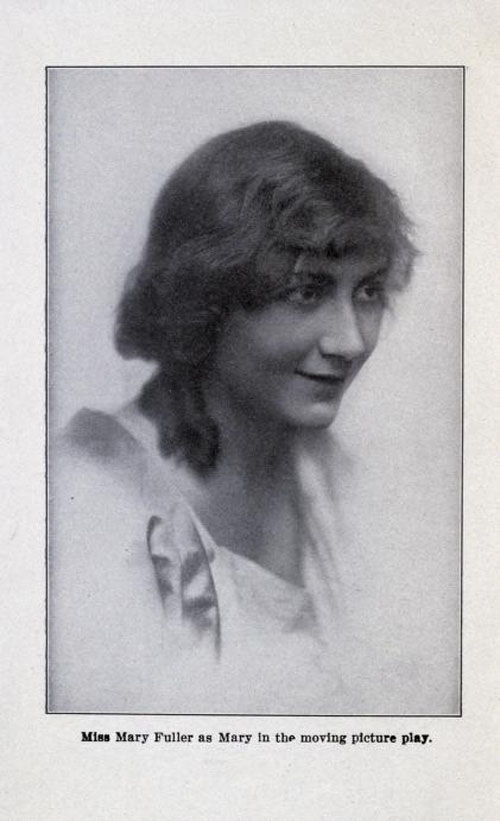By Doug Boilesen, 2022
The first of the twelve serialized stories
for What Happened to Mary was released in July 1912 by
McClure's The Ladies' World magazine. Edison's film
studio made twelve one-reel episodes and released one monthly starting
July 26, 1912 to coincide with the serial story of the same name's
publication in The Ladies' World magazine. What Happened
to Mary was performed as a stage play and also published as a
novel titled What
Happened to Mary - A Novelization from the Play and the
Stories and the Stories Appearing in the Ladies' World by Robert
Carlton Brown (New York Grossett & Dunlop, 1913).
Two of the episodes have connections
with the phonograph.
In Episode One Mary has lived under
the care of Billy, a shop keeper, for eighteen years and it's unknown
why her parents abandoned her. Billy had promised Mary that they would
someday get a phonograph and Mary had looked forward to the arrival
of the "phonograph as to a glimpse of heaven."
In Episode Seven the phonograph plays
a key role in recording an incriminating conversation which is then
played at a criminal trial.
The following provide details and the
text related to those two phonograph connections.
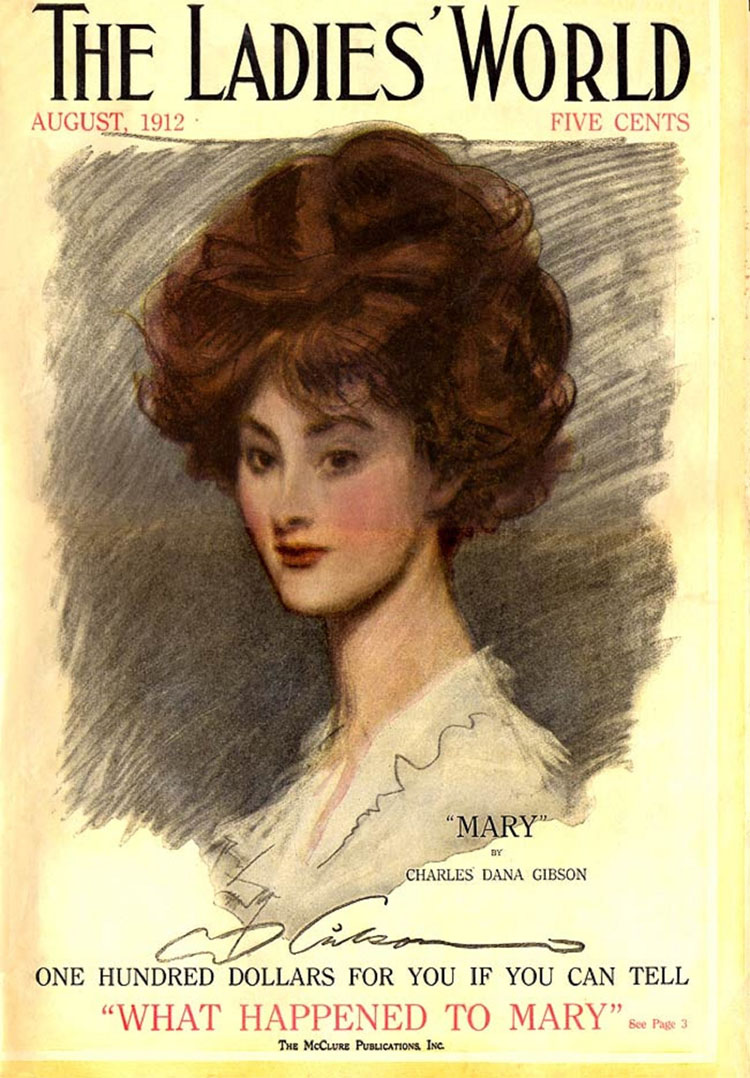
Courtesy of Norman
Studios On-line Museum
"False to their Trust"
- Episode VII Summary
In the seventh episode of the serial
titled "False to their Trust" the phonograph helps bring
about the conviction of Mary's Uncle Craig and his son, Cousin Henry,
who were embezzling their bank. The original plan was for Mary to
listen in on an important conversation while hiding in the storeroom
and to take notes. Once inside the storeroom, however, Mary saw a
phonograph and realized that it would provide much better evidence
than her transciptions. She knows exactly how to use the phonograph
and captures incriminating words from her uncle and cousin.
At the Craigs' trial and after the courtroom
and heard the phonograph's record the defense announced that it would
introduce no testimony. "What's
the use of perjuring yourself?" the prisoners' chief counsel advised
the Craigs. "That girl and that
phonograph record nailed you to the cross."
See Photo Play Theatres' newspaper
promotion and synopsis for Episode 7 of the film "What Happened
to Mary" which was showing in January 1913 at Lincoln, Nebraska's
Lyric Theatre.
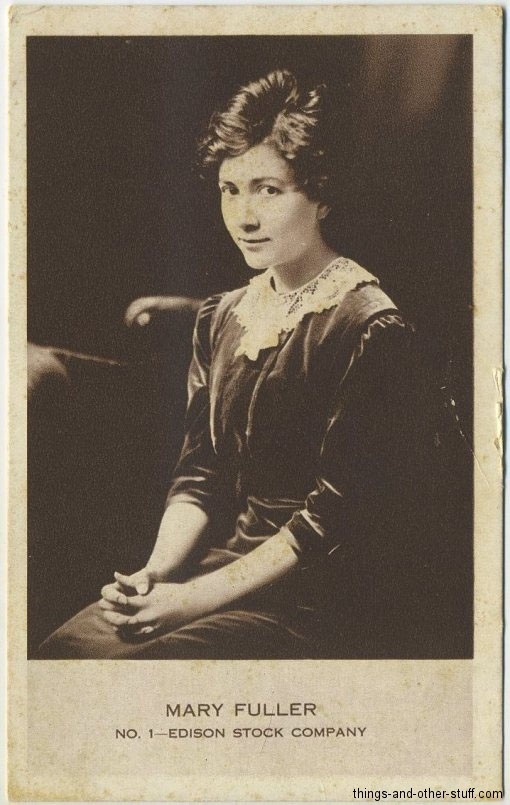
Courtesy of things-and-other-stuff.com
The following excerpts come from the
book What
Happened to Mary - A Novelization from the Play and the
Stories and the Stories Appearing in the Ladies' World by Robert
Carlton Brown (New York Grossett & Dunlop, 1913) with phonograph
connections highlighted followed by respective pages from the book.
Episode VII of the serial/film "False
to their Trust" ( Brown's novelization chapters titled "Detective
Work" and "The Trial")
Page 228
Then there was silence. Meantime, Mary's
wandering gaze had settled on a dusty commercial phonograph standing
on top of a pile of blank checkbooks. She had both given and taken
dictation by phonograph in Eayner's office, and thoroughly understood
the instrument.
A thought flashed instantaneously through
her mind. A tangible record of the conversation between the Craigs
would be much more valuable as evidence than any shorthand notes she
could make.
It was the work of a second to step
to the phonograph and slip in place one of the fresh records from
a box beside the machine. Her hands flew. Finding that the dictation
machine was already wound up, she set the mechanism going and thrust
the receiver into the dictating horn just as Henry Craig replied slowly.
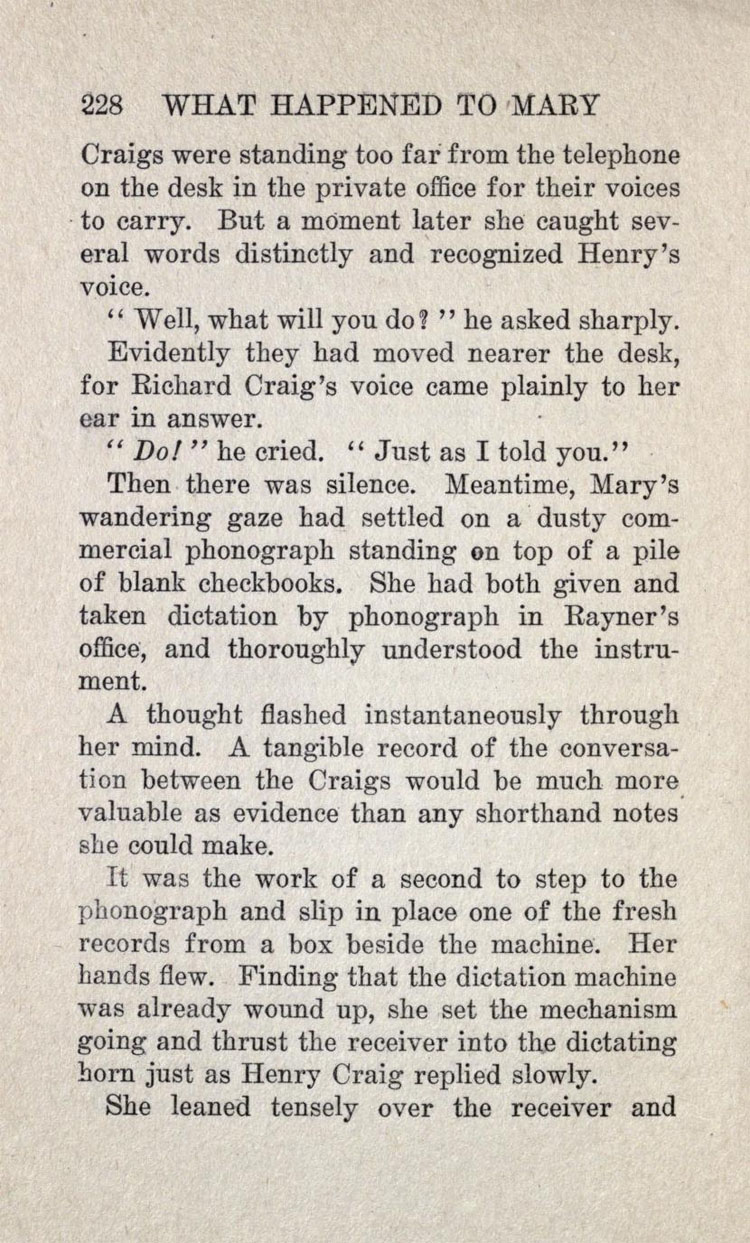
Page 230-231
"Yes, go out and take her through
the bank; she's interested. I think it's a good sign that she came
down here of her own accord. Make Mary hung up the receiver. The phonograph
record was complete. She had no more time to listen to the disgusting
revelations. Slipping out the neat little cylinder of wax, she held
it up triumphantly, then wrapped it quickly in a filmy handkerchief
and placed it carefully in her hand-bag.
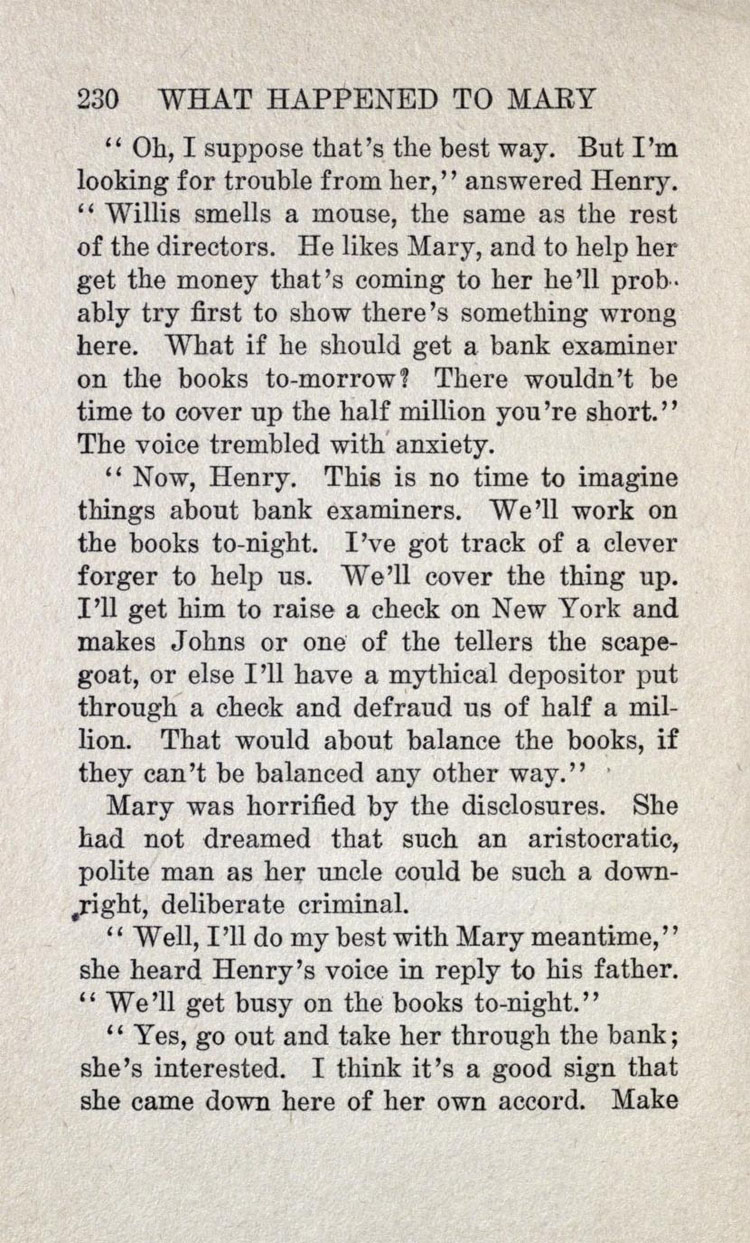

Page 241-242
Mary told, with rising excitement, of
the Craigs' talk about raising checks. Then she explained how she
had inserted the telephone receiver in the horn of the phonograph,
and of her preservation of the waxen record of their remarks, which
she had afterward sent to the District Attorney by John Willis.
When she had finished, Mr. Hovey produced
the record and Mary identified it as the one she had made. Amid strenuous
objections on the part of the defendants' lawyers, Judge Bussel ruled
the record competent evidence, "For the purpose of corroborating the
witness, Mary Craig."
It was a tremendously dramatic moment
when the hard voice of Eichard Craig was reproduced by the phonograph
and carried to the intently listening men in the jury box. When Henry
Craig's voice took part in the conversation, and the hideously incriminating
plot was repeated in all its damning detail, the set faces of the
twelve men who were to decide the question of the guilt or innocence
of the accused held their verdict so plainly written that all might
read it. The prisoners, keenly alive to the fate that awaited them,
wilted in their chairs.
"The State rests," snapped District
Attorney Hovey as Mary stepped from the stand, amid a subdued buzzing
from the spectators, and imperative thumping and orders of court attendants
endeavoring to maintain silence.
Ashy-faced, the two defendants huddled
together, while their counsel made sundry objections, motions to expunge
the records, and to dismiss the indictment on the ground that no criminal
intent had been proven. They were promptly overruled and, after a
hurried whispered conference, the defense announced that it would
introduce no testimony.
"What's the use of perjuring yourself?"
the prisoners' chief counsel advised the Craigs.
"That girl and that phonograph record
nailed you to the cross."
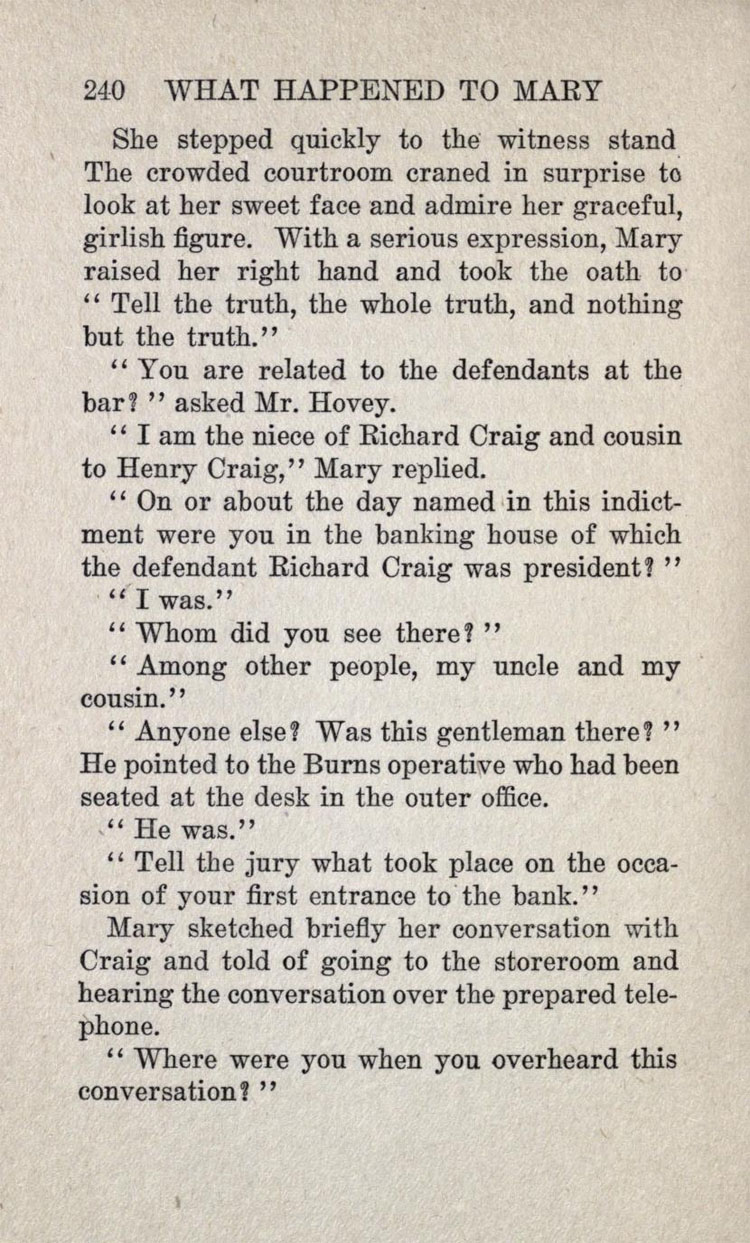
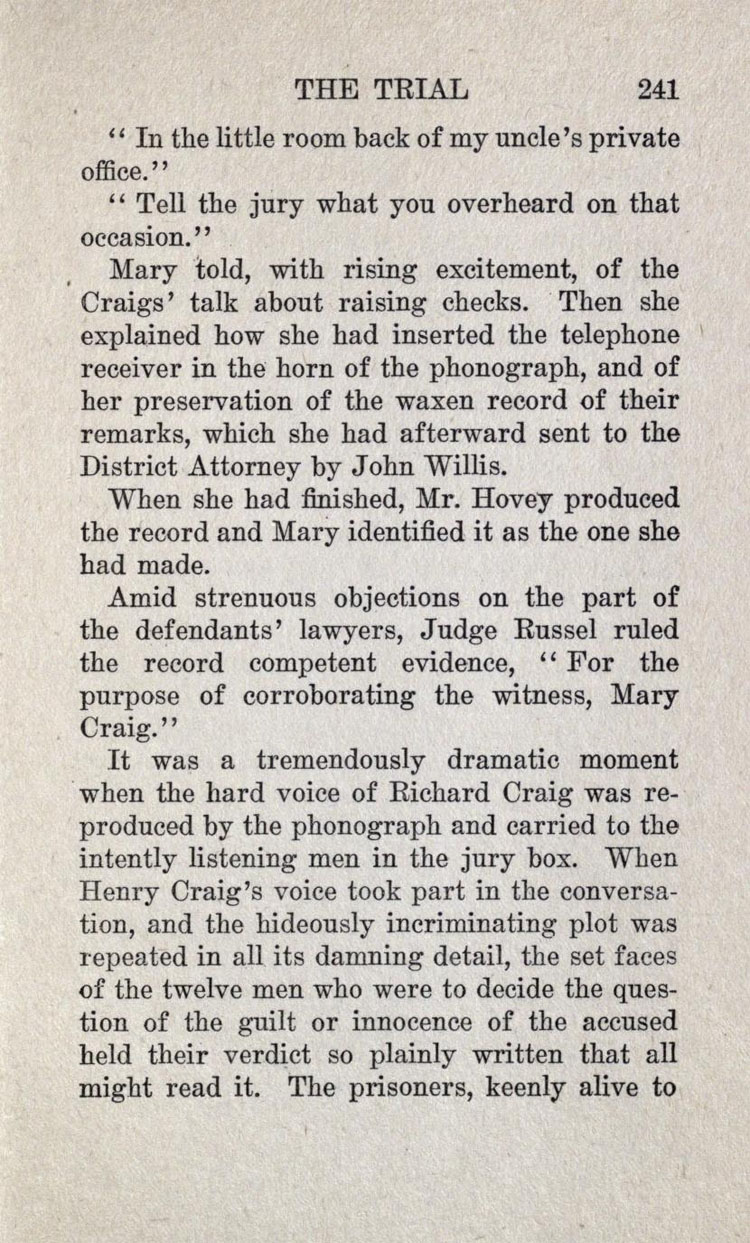
Episode I of the serial/film
"Escape from Bondage" (Chapter Two of Brown's novelization
titled "Free")
"There short sail over, Mary
returned to the store. Billy Peart had brought back a long-promised
phonograph from Truscutt to be used as a business stimulator during
the dull, dreary winter. Mary had looked forward to the arrival
of that phonograph as to a glimpse of heaven. Now she listened listlessly,
her thoughts astray as she dropped into a chair and heard the rhythmic
wail of the Miserere. Slowly the music drifted into her thoughts;
it stirred her, differently than the church choir, differently than
the two twinkling pianos in the village. This music had in it the
same human note that she had found in the chant in the fisherman
as they rode in through the storm...She thought of going to her
room. She felt like crying alone. But just then Billy Peart put
on the record of "The Blue Danube" and she lingered to
listen."
FACTOLA: Edison's twelve one-reel
moving picture play of the episodes of "What Happened to Mary"
is the first serialized movie in the United States. With release of
episode one starting July 26, 1912 to coincide with the serial story
of the same name's publication in The Ladies' World magazine
this serial became a popular culture marker. MoMA
summarized this success as follows: "Starring the popular
Mary Fuller as a foundling in search of her biological parents, the
series was a sensation—inspiring fashion layouts, songs, a novelization,
a board game, a Broadway play, and the 1913 sequel (now lost) Who
Will Mary Marry?."

Announcement of six-more "Who Will
Marry Mary?" episodes to be made by Edison, "The Kinetogram,"
June 15, 1913
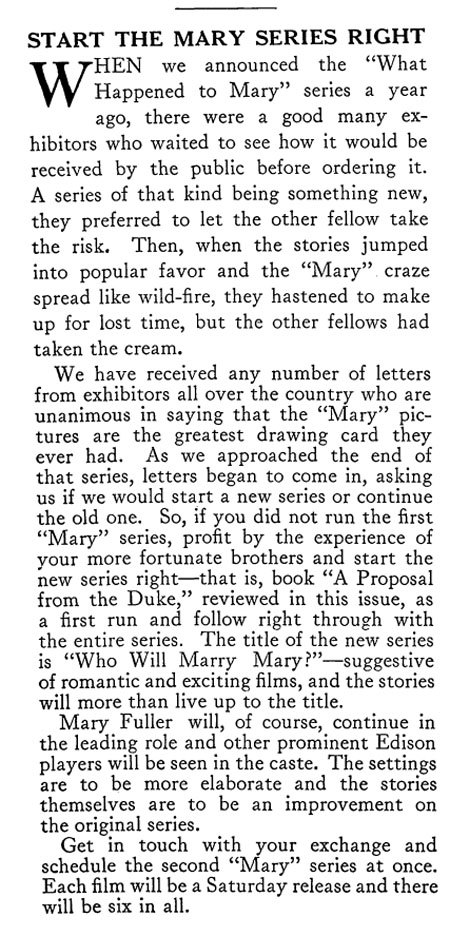
Edison Promotion for the
upcoming six new films for "Who Will Marry Mary?" "The
Kinetogram," July 15, 1913
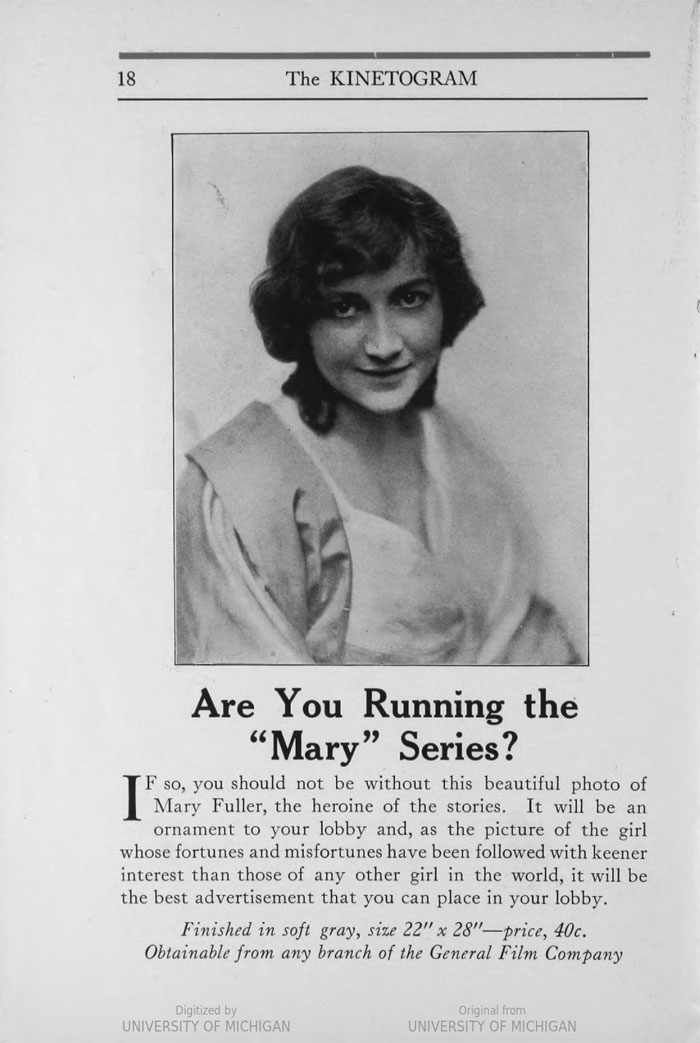
Edison Lobby Promotion
for "Who Will Marry Mary?" "The Kinetogram," August
15, 1913
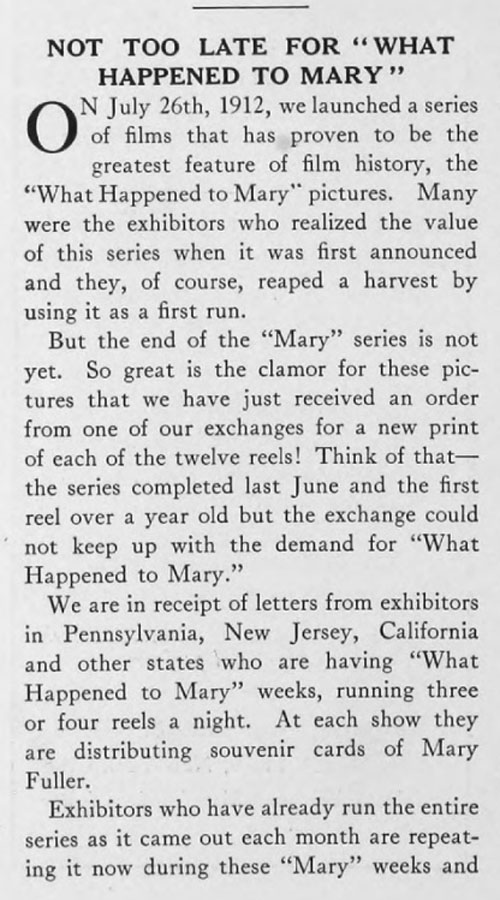

Edison Promotions for
"Who Will Marry Mary?" "The Kinetogram," September
15, 1913
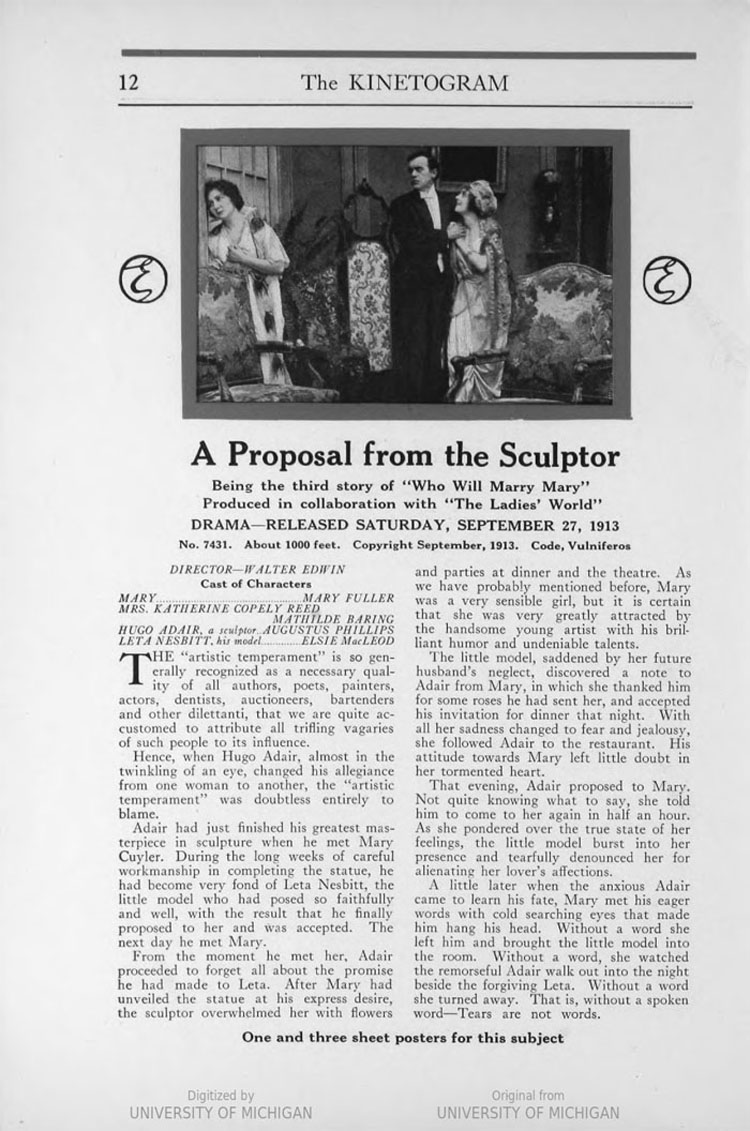
Edison Promotions for
"Who Will Marry Mary?" "The Kinetogram," October
15, 1913
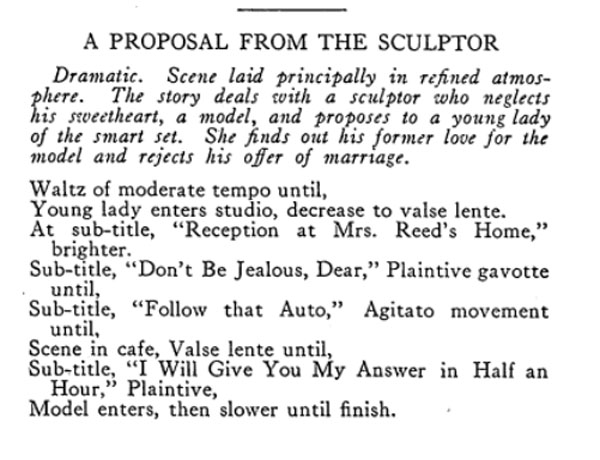
Music Ques for third
in the series of "Who Will Marry Mary?" "The Kinetogram,"
October 15, 1913
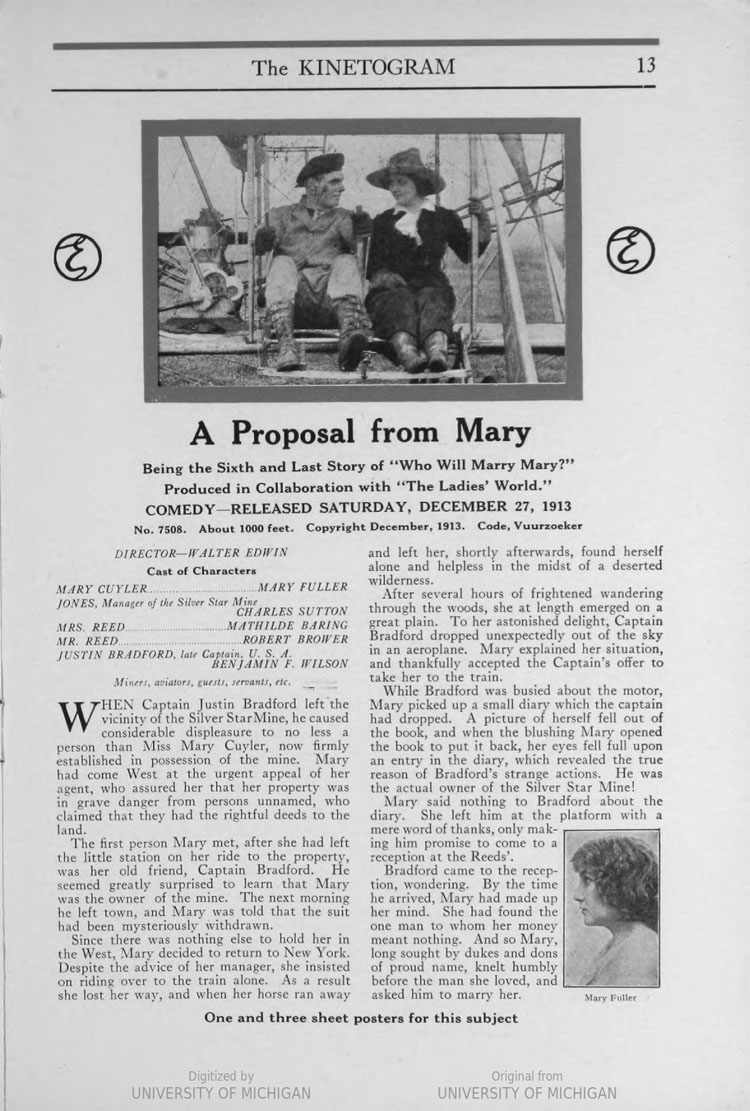
The last in the series
of "Who Will Marry Mary? "The Kinetogram," December
15, 1913
